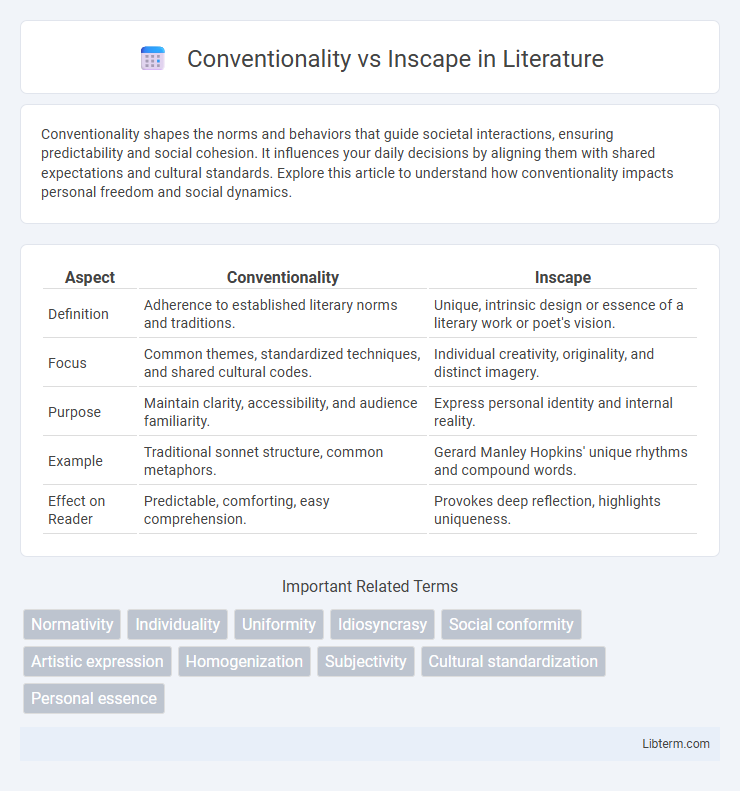Conventionality shapes the norms and behaviors that guide societal interactions, ensuring predictability and social cohesion. It influences your daily decisions by aligning them with shared expectations and cultural standards. Explore this article to understand how conventionality impacts personal freedom and social dynamics.
Table of Comparison
| Aspect | Conventionality | Inscape |
|---|---|---|
| Definition | Adherence to established literary norms and traditions. | Unique, intrinsic design or essence of a literary work or poet's vision. |
| Focus | Common themes, standardized techniques, and shared cultural codes. | Individual creativity, originality, and distinct imagery. |
| Purpose | Maintain clarity, accessibility, and audience familiarity. | Express personal identity and internal reality. |
| Example | Traditional sonnet structure, common metaphors. | Gerard Manley Hopkins' unique rhythms and compound words. |
| Effect on Reader | Predictable, comforting, easy comprehension. | Provokes deep reflection, highlights uniqueness. |
Understanding Conventionality: Definition and Origins
Conventionality refers to the established norms and shared agreements that govern language, behavior, and meaning within a cultural or social context, rooted in the collective consensus of a community. Its origins trace back to linguistic theories by Ferdinand de Saussure, emphasizing that signs derive meaning through agreed conventions rather than inherent properties. Understanding conventionality involves recognizing these societal contracts that enable effective communication and social order.
Inscape Explained: Meaning and Historical Context
Inscape, a term coined by poet Gerard Manley Hopkins, refers to the unique inner nature or essence of a thing that distinguishes it from all others, emphasizing individuality and intrinsic form. Historically rooted in the Victorian era's literary movement, inscape opposes conventionality by celebrating irregularity, uniqueness, and authentic self-expression rather than conforming to societal norms or standardized aesthetics. This concept profoundly influenced modernist poetry and criticism by advocating for an artistic focus on individual perception and the distinctiveness of experience.
The Role of Tradition in Shaping Conventionality
Tradition serves as the foundation for conventionality by establishing shared norms and practices that guide cultural and social behavior across generations. These inherited conventions create a common framework for communication and interpretation, contrasting with the uniqueness and individual expression emphasized by inscape. The role of tradition in shaping conventionality ensures stability and continuity within societies by reinforcing collective identities and customary patterns.
Inscape and Individual Perception: Uniqueness in Art and Literature
Inscape emphasizes the unique inner essence of an individual artist or writer, highlighting the distinct personal perspective embedded in their work that defies conventional norms. This concept prioritizes subjective experience and intrinsic vision, creating art and literature that resonate with originality and authenticity. Rooted in the belief that each creator's perception is inherently singular, inscape challenges standardized interpretations and celebrates individual creativity.
Conventionality in Culture and Society
Conventionality in culture and society refers to the established norms, traditions, and shared practices that shape collective behavior and communication. These conventions facilitate social cohesion by providing predictable frameworks for interactions, language use, and cultural expression, reinforcing group identity and continuity. Understanding conventionality is crucial for analyzing how social order is maintained and how cultural meanings are constructed and transmitted across generations.
Inscape in Creative Expression: Breaking the Mold
Inscape in creative expression emphasizes the unique inner nature and individuality of an artwork, breaking away from conventionality by capturing the artist's distinct perspective and emotional depth. This concept prioritizes the intrinsic qualities that differentiate a piece, fostering originality and authentic self-expression. By focusing on inscape, creators challenge standardized norms and cultivate innovation through personal vision.
Key Differences Between Conventionality and Inscape
Conventionality centers on shared cultural norms and standardized symbols that enable collective understanding, whereas inscape emphasizes the unique, individual perception of reality shaped by personal experiences and inner vision. Conventionality relies on external rules and societal conventions to communicate meaning, while inscape prioritizes an internal, subjective expression that may defy normative expectations. The key difference lies in conventionality's focus on uniformity and social agreement, contrasted with inscape's celebration of originality and personal creativity.
Case Studies: Conventionality vs Inscape in Literature
Case studies in literature reveal how conventionality structures narratives through familiar themes and stylistic norms, promoting reader anticipation and cultural coherence. In contrast, inscape emphasizes the unique, individual perspectives that disrupt these norms, spotlighting personal identity and subjective experience. Analyzing works like Gerard Manley Hopkins' poetry illustrates inscape's vivid imagery and rhythm, challenging conventional literary forms and enriching textual interpretation.
The Impact of Conventionality on Innovation
Conventionality often limits innovation by enforcing established norms and predictable patterns that inhibit creative experimentation. Inscape, representing the unique inner essence of an idea or entity, thrives when freed from conventional constraints, allowing novel perspectives and original solutions to emerge. Understanding the tension between conventionality and inscape highlights how breaking away from standard practices can drive groundbreaking advancements and transformative innovation.
Embracing Inscape: Benefits for Personal and Artistic Growth
Embracing inscape allows individuals to cultivate a unique personal identity by expressing their inner landscape through creative mediums, enhancing self-awareness and authenticity. This inward focus fuels artistic growth by fostering originality and depth, diverging from conventional norms that often limit innovation. By prioritizing inscape, artists and individuals experience a transformative journey that enriches both their creative output and personal development.
Conventionality Infographic

 libterm.com
libterm.com